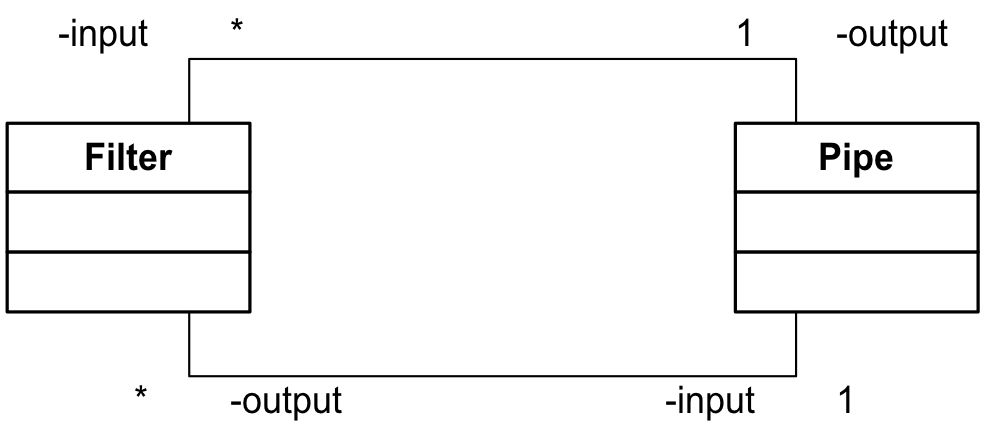Object-Oriented Programming
Software Architecture
Michael L. Collard, Ph.D.
Department of Computer Science, The University of Akron
System/Subsystem Design
System/Subsystem Design
- subsystem provides a set of services to the system
- A set of related operations that share a common purpose
- subsystem interface a set of services available to other systems
- Application Programmer Interface (API) includes the names of operations, parameters/types, and return types
- System design focuses on defining services
Architectural Style
An architectural style defines a family of systems in terms of a pattern of structural organization
- components, e.g., client, server, DB
- connectors, e.g., procedure call, pipe, event broadcast
- Consists of:
- Vocabulary of components and connectors
- Constraints on how they are combined
Common Architectural Styles
- Dataflow Systems: Pipe and Filter, Batch Sequential
- Virtual Machines: Rule-based Systems, Interpreters
- Repository: Databases, Hypertext Systems, Blackboards
- Independent Components: Peer-to-Peer, Client Server, Model/View/Controller, Event Driven
- Call and Return Systems: Main Program and Subroutines, Layered Systems, Object-Oriented Systems
Pipe and Filter Architecture

Pipe and Filter Architecture

- Subsystems are called filters and associations between the filters are called pipes
- Filters only know the content and format of data being received and produced, nothing about the other filters in the system
- Filters execute concurrently with synchronization via pipes
- Very reconfigurable
- Transformational systems
Pipe and Filter Example
Batch Sequential Architecture
Batch Sequential Architecture
- A small number of large stand-alone subsystems
- Must be executed in a fixed sequential ordering (batch)
- Typically work on large flat files, transforming the file into a new format or a new ordering so the next subsystem can work on the data
- The shared, specific file tightly couples the subsystems
- No real-time feedback, no concurrency
Batch Sequential Example
Batch Sequential Example
- Validate must complete and output before Sort
- Sort must complete and output before Update
- Update must complete and output before Report
- Each subsystem may have a different output format
- Each subsystem is developed based on the previous subsystem's output format
- No concurrency
Layered Architecture
Hierarchical decomposition of a system into subsystems (layers), with each providing a higher level of services provided from lower-level subsystems
- E.g., Presentation Layer
- E.g., Business Layer
- E.g., Data Layer
Closed Architecture: OSI Network Model
- closed architecture
- Each layer can only depend on the layer immediately below
- For data, it must flow from bottom to top, stopping at every layer
Open Architecture: Motif Library
- open architecture
- Each layer can access any layer below
- Functionality and can be accessed from any layer below
Repository Architecture
Repository Architecture
- Subsystems are independent and interact by a central repository
- Examples: Payroll or banking system, Modern IDE/Compiler, Blackboard
Repository: IDE

Model/View/Controller
Model/View/Controller
- Subsystems
- model subsystems are responsible for maintaining domain knowledge
- view subsystems are for displaying knowledge to the user
- controller subsystems manage the interactions with the user
- Model subsystems do not depend on view or controllers.
- Changes in model state propagate via a subscribe-notify protocol
- Examples: File system, database
Client/Server Architecture
Client/Server Architecture
- Subsystems:
- Server provides one or more services to instances of clients
- Clients ask for services, and clients interact with users
- An information system with a central DB is an example
- Web servers (multiple servers)
Peer-to-Peer Architecture
Peer-to-Peer Architecture
- Generalization of client/server, clients can be servers and vice versa
- The control flow of each subsystem is independent of others except for the synchronization of requests.
Comparison
Virtual Machine Architecture
Virtual Machine Architecture
- Program Holds a program to execute in a particular language, probably a DSL
- Interpreter Knows how to decode the language instruction
- WorkingMemory Memory for the VirtualMachine
- VirtualMachine
- Fetch the instruction
- Fetch the data
- Execute the instruction
- Store the result in the WorkingMemory
- Update the Interpreter
Process Control Architecture
Process Control Architecture
- Controller gets feedback from a set of Sensors
- Controller performs actions on a set of Actuators
Event-Driven Architecture
Event-Driven Architecture
- Main EventLoop controls Subsystems
- Subsystem contains handlers
- EventLoop notifies Subsystems
Plug-In Architecture

- core system
- plug-in components
- Mix and match freely
- E.g., builtin vs. plug-in parsers
Observations
- Each of the architectures controls how you add subsystems to the system
- May define the output and input path
- May define characteristics of the output and input format
- Difficult to add a subsystem that does not fit the architecture
- Each type may be linked to a particular industry or application type










